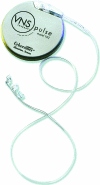Vagus Nerve Stimulation (VNS) and Treatment of Depression: To the Brainstem and Beyond
- PMID: 21103178
- PMCID: PMC2990624
Vagus Nerve Stimulation (VNS) and Treatment of Depression: To the Brainstem and Beyond
Abstract
Neuromodulation appears to be emerging gradually as a new therapeutic field in psychiatric treatment. It encompasses neuropsychiatric medical devices, such as vagus nerve stimulation (VNS), transcranial magnetic stimulation (TMS), deep brain stimulation (DBS), and electroconvulsive therapy (ECT). As a therapeutic approach to affective disorders, neuromodulation shifts the focus from the monoamine synapse to neural circuitry of the brain, which is dysregulated in depression. This neural circuitry has been elaborated on over the course of 15 years of neuroimaging research in mood disorders and is now believed to encompass disturbances in a frontolimbic network. These include reduced metabolism and blood flow in the prefrontal cortex and anterior cingulate and pathologically increased activity in the subgenual cingulate and amygdala.VNS is an implanted device that has established efficacy in pharmaco-resistant epilepsy. It was approved by the FDA for the treatment of severe, recurrent unipolar and bipolar depression in July of 2005. VNS adopts a bottom-up approach to modulating the neural circuitry of depression by stimulating vagal afferent fibers in the neck, which carry impulses to the brain stem to target there the locus ceruleus and dorsal raphe nucleus. Now that VNS has moved beyond the experimental phase and into the clinic, psychiatrists are faced with deciding who is an appropriate patient for this surgical implant and how to integrate VNS into existing treatment in order to optimize both efficacy and safety.This review of VNS will assess the efficacy and safety data that led to the FDA approval. We will also review for the busy clinician how VNS is likely to translate into clinical practice as a treatment option for patients in need who are suffering from severe depression.
Keywords: VNS; frontolimbic network; neuromodulation.
Figures
Similar articles
-
The Efficacy and Safety of Neuromodulation Treatments in Late-Life Depression.Curr Treat Options Psychiatry. 2020 Sep;7(3):337-348. doi: 10.1007/s40501-020-00216-w. Epub 2020 Jun 3. Curr Treat Options Psychiatry. 2020. PMID: 33585164 Free PMC article.
-
Recordings from the rat locus coeruleus during acute vagal nerve stimulation in the anaesthetised rat.Neurosci Lett. 2005 May 13;379(3):174-9. doi: 10.1016/j.neulet.2004.12.055. Epub 2005 Jan 26. Neurosci Lett. 2005. PMID: 15843058
-
Vagus nerve stimulation: An update on a novel treatment for treatment-resistant depression.J Neurol Sci. 2022 Mar 15;434:120171. doi: 10.1016/j.jns.2022.120171. Epub 2022 Jan 29. J Neurol Sci. 2022. PMID: 35158102 Review.
-
Vagus nerve stimulation in depression.Expert Opin Pharmacother. 2001 Jul;2(7):1061-3. doi: 10.1517/14656566.2.7.1061. Expert Opin Pharmacother. 2001. PMID: 11583056 Review.
-
Cervical vagus nerve stimulation augments spontaneous discharge in second- and higher-order sensory neurons in the rat nucleus of the solitary tract.Am J Physiol Heart Circ Physiol. 2017 Aug 1;313(2):H354-H367. doi: 10.1152/ajpheart.00070.2017. Epub 2017 May 5. Am J Physiol Heart Circ Physiol. 2017. PMID: 28476920 Free PMC article.
Cited by
-
"The Wandering Nerve Linking Heart and Mind" - The Complementary Role of Transcutaneous Vagus Nerve Stimulation in Modulating Neuro-Cardiovascular and Cognitive Performance.Front Neurosci. 2022 Jun 16;16:897303. doi: 10.3389/fnins.2022.897303. eCollection 2022. Front Neurosci. 2022. PMID: 35784842 Free PMC article. Review.
-
Vagus nerve stimulation in the non-human primate: implantation methodology, characterization of nerve anatomy, target engagement and experimental applications.Bioelectron Med. 2023 Apr 28;9(1):9. doi: 10.1186/s42234-023-00111-8. Bioelectron Med. 2023. PMID: 37118841 Free PMC article.
-
Recent progress on peripheral neural interface technology towards bioelectronic medicine.Bioelectron Med. 2020 Nov 30;6(1):23. doi: 10.1186/s42234-020-00059-z. Bioelectron Med. 2020. PMID: 33292861 Free PMC article. Review.
-
Vagus nerve stimulation in Parkinson's disease: a scoping review of animal studies and human subjects research.NPJ Parkinsons Dis. 2024 Oct 24;10(1):199. doi: 10.1038/s41531-024-00803-1. NPJ Parkinsons Dis. 2024. PMID: 39448636 Free PMC article.
-
Solenoidal Micromagnetic Stimulation Enables Activation of Axons With Specific Orientation.Front Physiol. 2018 Jul 27;9:724. doi: 10.3389/fphys.2018.00724. eCollection 2018. Front Physiol. 2018. PMID: 30140230 Free PMC article.
References
-
- Murray C, Lopez A. Cambridge, MA: Harcourt University Press; 1996. The Global Burden of Disease: A Comprehensive Assessment of Mortality and Disability from Diseases, Injuries and Risk Factors in 1990 and Projected to 2020.
-
- Sackeim HA. The definition and meaning of treatment-resistant depression. J Clin Psychiatry. 2001;16:10–7. - PubMed
-
- Trivedi M, Rush A, Wisniewski S, et al. Evaluation of outcomes with citalopram for depression using measurement-based care in STAR*D: implications for clinical practice. Am J Psychiatry. 2006;163:28–40. - PubMed
-
- DeRubeis RJ, Hollon SD, Amsterdam JD, et al. Cognitive therapy vs medications in the treatment of moderate to severe depression. Arch Gen Psychiatry. 2005;62:409–16. - PubMed
-
- Husain MM, Rush AJ, Fink M, et al. Speed of response and remission in major depressive disorder with acute electroconvulsive therapy (ECT): A Consortium for Research in ECT (CORE) report. J Clin Psychiatry. 2004;65:485–91. - PubMed
LinkOut - more resources
Full Text Sources
Other Literature Sources
Medical
Research Materials


